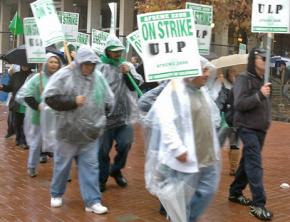We stand with UC workers
Thousands of AFSCME Local 3299 workers went on a one-day strike throughout the University of California (UC) system on November 20.
The union, which represents 22,000 service and patient care technical workers across 10 UC campuses, five medical centers, and numerous clinics and research laboratories, is demanding an end to the administration's campaign of illegal intimidation against union members who took part in a two-day walkout in May over unsafe staffing levels at UC hospitals.
The union has been trying to negotiate a new contract with UC for the past 18 months. Earlier this year, negotiations broke down, with roughly 40 contract articles at issue. Currently, UC patient care and service workers are working without a contact.
Here, and describe how students at UC San Diego (UCSD) organized support for the one-day strike in November.
STUDENTS ACROSS the University of California (UC) system organized with campus service workers to build for the unfair labor practice strike on November 20 called by AFSCME, the largest union in the UC system.
AFSCME Local 3299, which represents some 22,000 workers, called the strike in response to retaliation and intimidation on the part of the UC administration toward hospital patient care workers who went on strike in May.
While the strike was predominately about the UC's aggressive intimidation tactics, it was also about raising awareness about the conditions facing campus service workers. UC campus workers face a severe short-staffing problem that has led to one in 10 workers being injured on the job.
Service workers are also being asked to pay more out of pocket into their pension and health care, while at the same time are getting their pay slashed by 1.5 percent. UC's top administrators however, got a 3 percent pay raise.
This disgusting display of the priorities of our university led students at UCSD to take action. The UC San Diego Strike Committee was born out of the UC-wide Student and Labor Organizing Conference in Riverside in September.

The UCSD Strike Committee worked all quarter to build for the November strike. Students began meeting on a weekly basis and collaborating with student organizations on campus, including MEChA, the UCSD chapter of the International Socialist Organization and Spaces, as well as other unions on campus, including the University Professional and Technical Employees, the United Auto Workers and the IWW.
The Strike Committee organized numerous actions in an attempt to bring awareness about the UC workers' struggle and the threat posed by the university's new president, Janet Napolitano, and to build for the strike.
Students organized a banner drop and speak-out on the first day of Napolitano's presidency, a teach-in and rally when Napolitano came to campus, and an interruption of the chancellor's speech, where students read off student and worker grievances and demands at the annual Founders' Day celebration.
The Strike Committee also tabled, held educational meetings, and put up fliers and posters all over campus exposing the university's gross treatment of campus service workers. Students also made "pledge cards" for undergraduate students to fill out to promise to strike in solidarity with campus workers.
What students of the committee quickly learned was that many workers didn't want to strike out of fear of retaliation from their supervisors. In the days prior to the strike, workers received letters from the administration stating that that the UC hoped that they "make the right decision" and not go out on strike.
THE NOVEMBER 20 strike however, was a success. At 8 a.m., some 150 striking AFSCME workers, 50 UAW graduate student workers, and 30 undergraduate students met at a parking structure on campus and began an impromptu march through campus, blocking intersections on their way back to the parking structure.
A rally was held at the parking structure, and then everyone marched to the nearby UCSD Thorton Hospital, where the campus crowd met with 200 striking workers. A large rally was held at the hospital before the campus group headed to the Campus Services Complex where the striking workers' managers offices are.
A campus organizer with AFSCME handed the managers letters stating that retaliation against striking workers will not be tolerated. There was another march through campus after lunch. The workers on the night shift came to the picket line at 5 p.m. when there was another march.
The day after the strike, students of the UCSD Strike Committee received notification that they are being charged with violating the student code of conduct at the university Founders' Day event.
This was the third annual Founders' Day action, and the first time that the university has taken disciplinary measures against students. It was a short protest in which students read off their demands and grievances during part of the Chancellor's speech, held a die-in symbolizing the death of the public university, and then marched publicizing the student and worker strike.
The UCSD Strike Committee feels that this year's student conduct charges are a political act related to their coordination of a student solidarity strike with workers. In regards to this action, students were cited in violation of the student conduct code, which restricts the "time, place and manner" of free speech on campus.
The students were cited under this new conduct code for disturbing the peace, failure to comply and disrupting a university activity, all of which are separate charges that are misapplied conduct code violations. Other students who participated weren't cited because they weren't organizers in the student solidarity strike.
A principal member of the UCSD Strike Committee, who was not present at the Founders' Day action, was cited the same day for "destruction of property" because she did not use the correct tape to hang posters regarding the strike.
Assistant Vice Chancellor Gary Ratcliff recorded the Founders' Day demonstration and used Facebook to compile students' identities, utilizing photos that were chosen for political content in order to frame those involved in the action in a particular context.
The official report mentions the students' involvement in the UCSD Strike Committee and the November 20 strike. Ratcliff also wrote the official report that brought the sanctions against the students.
As an assistant Vice Chancellor, Ratcliff oversees Student Legal Services and other student administrative bodies on campus and has a history of harassing and intimidating student organizers in past actions.
Since the students received notification of the charged, they have began a letter writing campaign by faculty and departments at UCSD and have started a petition for anyone standing in solidarity with the students facing charges.
We must let the UCSD administration know that students will not be intimidated out of organizing alongside workers--and that student-worker power is greater than some "violation" of the student code of conduct.


